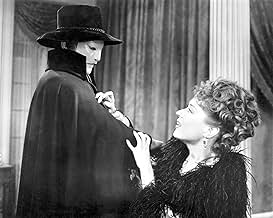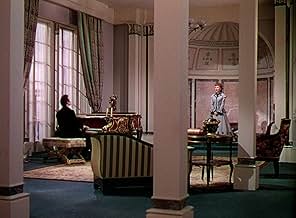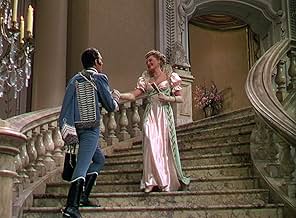VALUTAZIONE IMDb
6,4/10
8924
LA TUA VALUTAZIONE
Aggiungi una trama nella tua linguaAn acid-scarred composer rises from the Paris sewers to boost his favorite opera understudy's career.An acid-scarred composer rises from the Paris sewers to boost his favorite opera understudy's career.An acid-scarred composer rises from the Paris sewers to boost his favorite opera understudy's career.
- Regia
- Sceneggiatura
- Star
- Vincitore di 2 Oscar
- 3 vittorie e 5 candidature totali
Kate Drain Lawson
- Landlady
- (as Kate Lawson)
Recensioni in evidenza
It's perfectly true that this version isn't Lon Chaney and is watered-down Leroux, but it still has excellent performances and - this was during WW II remember - extraordinarily beautiful production values which resulted in Oscars for Color Cinematography and Art/Set Decoration. I've loved this film since I was a kid, even though back then I had to endure black-and-white telecasts because the local CBS affiliate was unable to obtain a color print that was up to their standards - years later I was lucky enough to see it - twice! in a theatre - as gorgeous as the color is on the DVD, it was even more breathtaking on the big screen. The extra features (the documentary "Phantom Unmasked", which includes a rare interview with the elusive Susannah Foster, and the audio commentary) have only increased my pleasure in watching this film over and over again.
This 1943 version is a remake of the 1925 version from the same studio (Universal). Probably the most vivid and effective use of Technicolor I have seen. Lush photography, great crane shots and an impressive Paris Opera House! The operatic scenes are very well done--and they are important to the story line. Very entertaining, especially since there is no graphic violence or gore--except the Phantom's face. Nelson Eddy is in top voice. One of Hollywood's most versatile actors, Claude Rains is remarkable in the lead role. Just the year before he was the memorable Prefect of Police in "Casablanca." This production is mounted first class in every way.
The DVD release is a fantastic transfer from an original old Technicolor master.
The DVD release is a fantastic transfer from an original old Technicolor master.
Before writing a film article on Claude Rains for CLASSIC IMAGES (December 2000), I took another look at 'Phantom' to appraise his performance. He's one of those rare actors who can make you feel sympathy when he plays the ill-treated violinist so that you understand why he turns into 'The Phantom'. His performance is just one asset of this handsome technicolor adaptation of the famous story. Why carp about the changes made for this version? It stands on its own as an entertaining melodrama studded with operatic sequences that give it added dimension. Nelson Eddy has never been in better voice and Susanna Foster is certainly up to the demands of her singing role. The comic aspects of the story are a bit overdone and the only weakness of the film is giving Eddy and Edgar Barrier silly routines as they compete for the hand of Foster. Aside from that, this can still be enjoyed as a horror story set against the Paris Opera background. The sets are rich and detailed. Understandably, the film won Academy Awards for color cinematography and color art direction. Edward Ward's haunting score was also nominated and contributes greatly to the overall enjoyment of the film. The horror is muted in this version--but the rich musical highlights are a compensation. Absorbing entertainment.
Gaston Leroux's penny-dreadful novel was hardly the stuff of great literature, but it did manage to tap into the public consciousness with its gas-light-Gothic tale of a beautiful singer menaced by a horrific yet seductive serial killer lurking in the forgotten basement labyrinths of the Paris Opera. Lon Chaney's silent classic kept the basic elements of the novel intact--and proved one of the great box office hits of its day, a fact that prompted Universal Studios to contemplate a remake throughout most of the 1930s.
Although several proposals were considered (including one intended to feature Deanna Durbin, who despised the idea and derailed the project with a flat refusal), it wasn't until 1943 that a remake reached the screen. And when it did, it was an eye-popping Technicolor extravaganza, all talking, all singing, and dancing. The Phantom had gone musical.
In many respects this version of PHANTOM anticipates the popular Andrew Lloyd Webber stage musical, for whereas the Chaney version presented the Phantom as a truly sinister entity, this adaptation presents the character as one more sinned against than sinning--an idea that would color almost every later adaptation, and Webber's most particularly so. But it also shifts the focus of the story away from the title character, who is here really more of a supporting character than anything else. The focus is on Paris Opera star Christine Dae, played by Susanna Foster. In this version Christine is not only adored by the Phantom; she is also romantically pursued by two suitors who put aside their differences to protect her.
Directed by Universal workhorse Arthur Lubin, this version is truly eye-popping as only a 1940s Technicolor spectacular could be: the color is intensely brilliant, and Lubin makes the most of it by focusing most of his camera-time on the stage of the Paris Opera itself and splashing one operatic performance after another throughout the film. But in terms of actual story interest, the film is only so-so. Susanna Foster had a great singing voice, but she did not have a memorable screen presence, and while the supporting cast (which includes Nelson Eddy, Edgar Barrier, Leo Carrillo, and Jane Farrar) is solid enough they lack excitement. And the pace of the film often seems a bit slow, sometimes to the point of clunkiness.
The saving grace of the film--in addition to the aforementioned photography, which won an Oscar--is Claude Rains. A great artist, Rains did not make the mistake of copying Chaney, and although the script robs the Phantom of his most fearsome aspects, Rains fills the role with subtle menace that is wonderful to behold, completely transcending the film's slow pace, the lackluster script, and "sanitized for your protection" tone so typical of Universal Studios in the 1940s. Unless you're a die-hard Phantom fan you're likely to be unimpressed.
Gary F. Taylor, aka GFT, Amazon Reviewer
Although several proposals were considered (including one intended to feature Deanna Durbin, who despised the idea and derailed the project with a flat refusal), it wasn't until 1943 that a remake reached the screen. And when it did, it was an eye-popping Technicolor extravaganza, all talking, all singing, and dancing. The Phantom had gone musical.
In many respects this version of PHANTOM anticipates the popular Andrew Lloyd Webber stage musical, for whereas the Chaney version presented the Phantom as a truly sinister entity, this adaptation presents the character as one more sinned against than sinning--an idea that would color almost every later adaptation, and Webber's most particularly so. But it also shifts the focus of the story away from the title character, who is here really more of a supporting character than anything else. The focus is on Paris Opera star Christine Dae, played by Susanna Foster. In this version Christine is not only adored by the Phantom; she is also romantically pursued by two suitors who put aside their differences to protect her.
Directed by Universal workhorse Arthur Lubin, this version is truly eye-popping as only a 1940s Technicolor spectacular could be: the color is intensely brilliant, and Lubin makes the most of it by focusing most of his camera-time on the stage of the Paris Opera itself and splashing one operatic performance after another throughout the film. But in terms of actual story interest, the film is only so-so. Susanna Foster had a great singing voice, but she did not have a memorable screen presence, and while the supporting cast (which includes Nelson Eddy, Edgar Barrier, Leo Carrillo, and Jane Farrar) is solid enough they lack excitement. And the pace of the film often seems a bit slow, sometimes to the point of clunkiness.
The saving grace of the film--in addition to the aforementioned photography, which won an Oscar--is Claude Rains. A great artist, Rains did not make the mistake of copying Chaney, and although the script robs the Phantom of his most fearsome aspects, Rains fills the role with subtle menace that is wonderful to behold, completely transcending the film's slow pace, the lackluster script, and "sanitized for your protection" tone so typical of Universal Studios in the 1940s. Unless you're a die-hard Phantom fan you're likely to be unimpressed.
Gary F. Taylor, aka GFT, Amazon Reviewer
Anybody approaching 'Phantom Of The Opera' as a horror movie will probably be disappointed, but if you look upon it as a romantic melodrama it's pretty entertaining. The sets (mostly recycled from the twenties version) are lavish, the music is strong and the performances are good, especially the wonderful Claude Rains ('The Invisible Man', 'Casablanca', 'Notorious') who is excellent (as always). The rest of the cast includes songbirds Nelson Eddy and Susanna Foster, the late Hume Cronyn in a bit part, and a nice cameo from Fritz Leiber (the father of the famous science fiction and fantasy writer Fritz Leiber, Jr) as Franz Liszt. 'Phantom Of The Opera' is far from my favourite Universal horror movie but I still enjoyed it and it's worth watching, though I think in many ways the Hammer remake in the 1960s starring Herbert Lom is a better movie.
Lo sapevi?
- QuizThe original script revealed Claudin to be Christine's father, who abandoned her and her mother in order to pursue a musical career. When this was excised from the final film, it left Claudin's obsession with Christine unexplained.
- BlooperWhen Christine takes the mask off from Phantom's face, we see that his scar reaches the low area of his right cheek, even the right eyelid is slightly fallen. But before that during the entire film, we never see a single mark of the scar on the uncovered area of the Phantom's face, not even the fallen eyelid through the mask.
- Citazioni
[Christine has left Raoul and Anatole in her dressing room while she greets a crowd of admirers]
Raoul D'Aubert: Would you join me for a bit of supper at the Cafe de l'Opera?
Anatole Garron: With pleasure, monsieur.
Raoul D'Aubert: Think we can get through this crowd?
Anatole Garron: Certainly. After all, who'd pay any attention to a baritone and a detective?
- ConnessioniFeatured in Weirdo with Wadman: Phantom of the Opera (1964)
- Colonne sonoreLULLABY OF THE BELLS
(uncredited)
Written by Edward Ward
Lyrics George Waggner
Sung by Susanna Foster and Nelson Eddy
I più visti
Accedi per valutare e creare un elenco di titoli salvati per ottenere consigli personalizzati
- How long is Phantom of the Opera?Powered by Alexa
Dettagli
- Data di uscita
- Paese di origine
- Lingua
- Celebre anche come
- El fantasma de la ópera
- Luoghi delle riprese
- Azienda produttrice
- Vedi altri crediti dell’azienda su IMDbPro
Botteghino
- Budget
- 1.500.000 USD (previsto)
- Tempo di esecuzione1 ora 32 minuti
- Mix di suoni
- Proporzioni
- 1.37 : 1
Contribuisci a questa pagina
Suggerisci una modifica o aggiungi i contenuti mancanti

Divario superiore
By what name was Il fantasma dell'opera (1943) officially released in India in English?
Rispondi





































